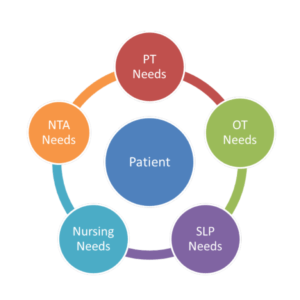Questions & answers from the American Association of Nurse Assessment Coordinators (AANAC)
Q: What is AANAC and how do I get my questions answered on the Resident Assessment Instrument/Minimum Data Set (RAI/MDS)?
A: The American Association of Nurse Assessment Coordinators is a nonprofit association of your peers, including all members of the interdisciplinary team dedicated to networking, education, and advocacy on behalf of all clinicians involved in the RAI/MDS process. From our online discussion group each week, we select the best questions and answers our members have raised. The questions and answers are reviewed by a national advisory board of experts in this field, and they are subsequently published in NAC News, AANAC’s weekly online newsletter. In addition to our weekly questions and answers, the newsletter contains a variety of timely and accurate information on this process. AANAC also offers certification and other educational information services for clinicians committed to accurate and timely completion of the MDS. For further information on AANAC, call (800) 768-1880 or visit https://www.aanac.org.
Q: Our therapy company wants us to change the ARD after it has already past. They say we have seven days to do this. I was under the impression you can only change the ARD up to the actual ARD, not after. Which is right?
A:You can change the ARD after it has been set but only if you are still within the window. If the window for setting the ARD has closed for that particular MDS, you cannot go back and change it. For example, for the 14-day assessment, the ARD window is days 11 through 19. On day 20, you can no longer set the ARD within the window or reset it. See page 2-40 of the RAI User’s Manual.
Q: A resident lost 10% of weight if you compare October with January but only lost 5% comparing July with January, and none comparing December with January. Do you code a loss on the MDS?
A:When determining weight loss, look at the weight for the current observation period. Then look back at the weights 1 month ago and 6 months back from the current observation period in order to make the determination. In your scenario, assuming your observation window is January, you said that there was no weight loss for 1 month—December to January—and that there was only a 5% weight loss for 6 months—July to January. So, the resident does not meet the definition of significant weight loss for this MDS. However, the resident has certainly had weight fluctuations, including a weight loss from October to January. The dietitian must assess this loss and care plan for it. See Pages 3-150 to 3-152.
Q: A resident with Parkinson’s disease cannot walk independently. He asks to use a framed wheeled walker because it allows him to leave the unit and walk independently around the facility, visiting his friends. He is unable to open the front of the device and exit on his own and must have the staff do this for him when he wants to get out of the walker. Is this device a restraint? Also, if it is considered a restraint, then how is it coded in Section P4?
A:Pages 3-199 and 3-200 of the RAI User’s Manual speak to the coding of this type of device. It is considered a chair that prevents rising (P4e = 1 or 2) if the resident cannot open the gate to exit (page 3-200) and should also be coded in G5a if it assists the resident to ambulate (page 3-199).
Q: Since nurses do not diagnose diseases and conditions, fecal impaction cannot be diagnosed by a nurse in H2d, right? Must there be supporting documentation from the physician to code it there?
A:A physician diagnosis is not required. The RAI User’s Manual instructions would specifically state that as a requirement if there were one, and it does not. According to the manual instructions, this item should be coded if hard stool is identified upon digital rectal exam or if stool is seen on an abdominal x-ray in the sigmoid colon or higher. For item H2d, fecal impaction, the nurse is not diagnosing the fecal impaction but, rather, the nurse is identifying symptoms. This is consistent with nursing practice—we should not be labeling or diagnosing conditions—we should be describing our findings in the clinical record, following the RAI User’s Manual instructions for MDS coding, and leaving the diagnosing to the folks who have the licenses to diagnose.It is a different story for Section I, however. No diagnosis should be coded there without a physician-documented diagnosis.
Q: Our company is requiring MDS Coordinators go back 120 days and do corrections on 5-day and/or 14-day assessments “to get higher RUG rates, because some facilities did not capture IV meds from hospital.” They also want us to “look at the ADLs” to see if they were inaccurately coded based on the look-back period and to change ARD dates on those assessments if it will result in a higher reimbursement rate. Is this permitted?
A:If the claim/medical record has not undergone a medical review by the fiscal intermediary (FI), then it can be adjusted based on the new RUG score, if applicable. (“Medical review” refers to the FI requesting the claim/medical record and making a coverage/payment determination.) It is allowable to go back 120 days from the “through” date of the claim in which the MDS was billed. You can correct MDS items coded in error; however you cannot go back and change ARD dates. Reference: Medicare Claims Processing Manual, Chapter 6, Section 30.5. Available at: www.cms.hhs.gov/manuals/downloads/clm104c06.pdf.
With thanks to Diane Carter, RN, MSN, CS, President and CEO of the American Association of Nurse Assessment Coordinators (AANAC).
Sidebar
About AANAC
Q: What is AANAC and how do I get my questions answered on the Resident Assessment Instrument/Minimum Data Set (RAI/MDS)?
A: The American Association of Nurse Assessment Coordinators is a nonprofi t association of your peers, including all members of the interdisciplinary team dedicated to networking, education, and advocacy on behalf of all clinicians involved in the RAI /MDS process. From our online discussion group each week, we select the best questions and answers our members have raised. The questions and answers are reviewed by a national advisory board of experts in this fi eld, and they are subsequently published in NAC News, AANAC’s weekly online newsletter. In addition to our weekly questions and answers, the newsletter contains a variety of timely and accurate information on this process. AANAC also offers certifi cation and other educational information services for clinicians committed to accurate and timely completion of the MDS. For further information on AANAC, call (800) 768-1880 or visit https://www.aanac.org
I Advance Senior Care is the industry-leading source for practical, in-depth, business-building, and resident care information for owners, executives, administrators, and directors of nursing at assisted living communities, skilled nursing facilities, post-acute facilities, and continuing care retirement communities. The I Advance Senior Care editorial team and industry experts provide market analysis, strategic direction, policy commentary, clinical best-practices, business management, and technology breakthroughs.
I Advance Senior Care is part of the Institute for the Advancement of Senior Care and published by Plain-English Health Care.
Related Articles
Topics: Articles , Regulatory Compliance











